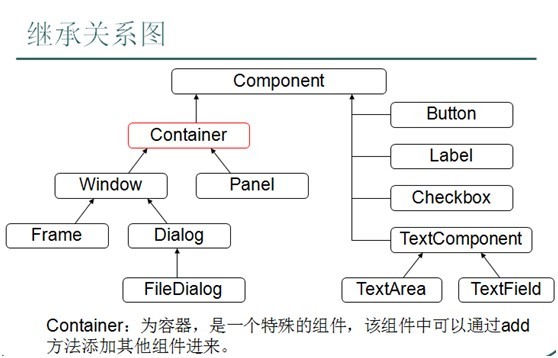本文主要是介绍【22】GUI图形用户界面,菜单栏打开,保存等操作,希望对大家解决编程问题提供一定的参考价值,需要的开发者们随着小编来一起学习吧!
8.1GUI(图形用户界面)
GUI
Graphical User Interface(图形用户接口)。
用图形的方式,来显示计算机操作的界面,这样更方便更直观。
CLI
Command line User Interface (命令行用户接口)
就是常见的Dos命令行操作。
需要记忆一些常用的命令,操作不直观。
举例:
比如:创建文件夹,或者删除文件夹等
Java为GUI提供的对象都存在java.Awt和javax.Swing两个包中。
8.2Awt和Swing
Awt与 Swing
java.Awt:Abstract WindowToolKit (抽象窗口工具包),需要调用本地系统方法实现功能。属重量级控件。
javax.Swing:在AWT的基础上,建立的一套图形界面系统,其中提供了更多的组件,而且完全由Java实现。增强了移植性,属轻量级控件。
容器中的组件的排放方式,就是布局。
常见的布局管理器:
FlowLayout(流式布局管理器)
8.3布局管理器
从左到右的顺序排列。
Panel默认的布局管理器。
BorderLayout(边界布局管理器)
东,南,西,北,中
Frame默认的布局管理器。
GridLayout(网格布局管理器)
规则的矩阵
CardLayout(卡片布局管理器)
选项卡
GridBagLayout(网格包布局管理器)
非规则的矩阵
8.4建立一个简单的窗体
Container常用子类:Window Panel(面板,不能单独存在。)
Window常用子类:Frame Dialog
简单的窗体创建过程:
Frame f = new Frame(“my window”);
f.setLayout(new FlowLayout());
f.setSize(500,400);//设置窗体大小
f.setLocation(300,200);//设置窗体出现在屏幕的位置
f.setVisible(true);
8.5事件监听机制的特点:
1,事件源。
2,事件。
3,监听器。
4,事件处理。
事件源:就是awt包或者swing包中的那些图形界面组件。
事件:每一个事件源都有自己特有的对应事件和共性事件。
监听器:将可以触发某一个事件的动作(不只一个动作)都已经封装到了监听器中。
以上三者,在java中都已经定义好了。
直接获取其对象来用就可以了。
我们要做的事情是,就是对产生的动作进行处理
确定事件源(容器或组件)
通过事件源对象的addXXXListener()方法将侦听器注册到该事件源上。
该方法中接收XXXListener的子类对象,或者XXXListener的子类XXXAdapter的子类对象。
一般用匿名内部类来表示。
在覆盖方法的时候,方法的参数一般是XXXEvent类型的变量接收。
事件触发后会把事件打包成对象传递给该变量。(其中包括事件源对象。通过getSource()或者,getComponent()获取。
练习一:创建一个图形化界面,并让窗体具备监听功能
import java.awt.*;
import java.awt.event.*;/*
创建图形化界面步骤:
1,创建frame窗体。
2,对窗体进行基本设置。比如大小,位置,布局。
3,定义组件。
4,将组件通过窗体的add方法添加到窗体中。
5,让窗体显示,通过setVisible(true)*/
class AwtDemo
{public static void main(String[] args){Frame f = new Frame("my awt");f.setSize(500,400);//窗体长宽f.setLocation(300,200);//窗体离屏幕左边,离屏幕上边多远f.setLayout(newFlowLayout());//窗体布局类型Button b = new Button("我是一个按钮");//创建一个按钮实例f.add(b);//将按钮添加到窗体中f.addWindowListener(newWindowAdapter(){public void windowClosing(WindowEvent e)//窗口关闭{System.out.println("我关");System.exit(0);}public void windowActivated(WindowEvent e)//窗口在屏幕最前端{System.out.println("我活了。");}public void windowOpened(WindowEvent e)//被打开时触发{System.out.println("我被打开了,hahahhahah");}});f.setVisible(true);//显示窗体//System.out.println("HelloWorld!");}
}
/*class MyWin implements WindowListener
{//覆盖7个方法。可以我只用到了关闭的动作。//其他动作都没有用到,可是却必须复写。}//因为WindowListener的子类WindowAdapter已经实现了WindowListener接口。
//并覆盖了其中的所有方法。那么我只要继承自Windowadapter覆盖我需要的方法即可。
class MyWin extends WindowAdapter
{public void windowClosing(WindowEvent e){//System.out.println("windowclosing---"+e.toString());System.exit(0);}
}*/
练习二:创建一个图形化界面,并让窗体及按钮都具备监听功能
//练习,定义一个窗体,在窗体中添加一个按钮具备关闭该窗体的功能。import java.awt.*;
import java.awt.event.*;class FrameDemo
{//定义该图形中所需的组件的引用。private Frame f;private Button but;FrameDemo(){init();}public void init(){f = new Frame("my frame");//对frame进行基本设置。f.setBounds(300,100,600,500);f.setLayout(newFlowLayout());but = new Button("my button");//将组件添加到frame中f.add(but);//加载一下窗体上事件。myEvent();//显示窗体;f.setVisible(true);}private void myEvent(){f.addWindowListener(new WindowAdapter(){public void windowClosing(WindowEvent e){System.exit(0);}});//让按钮具备退出程序的功能/*按钮就是事件源。那么选择哪个监听器呢?通过关闭窗体示例了解到,想要知道哪个组件具备什么样的特有监听器。需要查看该组件对象的功能。通过查阅button的描述。发现按钮支持一个特有监听addActionListener。*/but.addActionListener(newActionListener(){private int count = 1;public void actionPerformed(ActionEvent e){//System.out.println("退出,按钮干的");//System.exit(0);//f.add(newButton("Button-"+(count++)));//f.setVisible(true);//f.validate();//System.out.println(e.getSource());Buttonb = (Button)e.getSource();Framef1 = (Frame)b.getParent();f1.add(newButton("button-"+count++));f1.validate();}});}public static void main(String[] args){new FrameDemo();}
}
练习三:鼠标,键盘监听应用
import java.awt.*;
import java.awt.event.*;class MouseAndKeyEvent
{private Frame f;private Button but;private TextField tf;MouseAndKeyEvent(){init();}public void init(){f = new Frame("my frame");f.setBounds(300,100,600,500);f.setLayout(newFlowLayout());tf = new TextField(20);but = new Button("my button");f.add(tf);f.add(but);myEvent();f.setVisible(true);}private void myEvent(){f.addWindowListener(newWindowAdapter(){public void windowClosing(WindowEvent e){System.exit(0);}});tf.addKeyListener(new KeyAdapter(){public void keyPressed(KeyEvent e){int code = e.getKeyCode();if(!(code>=KeyEvent.VK_0&& code<=KeyEvent.VK_9)){System.out.println(code+".....是非法的");e.consume();}}});//给But添加一个键盘监听。but.addKeyListener(newKeyAdapter(){public void keyPressed(KeyEvent e){ if(e.isControlDown()&&e.getKeyCode()==KeyEvent.VK_ENTER)//System.exit(0);System.out.println("ctrl+enteris run");//System.out.println(KeyEvent.getKeyText(e.getKeyCode())+"...."+e.getKeyCode());}});/*but.addActionListener(newActionListener(){public void actionPerformed(ActionEvent e){System.out.println("actionok");}});*//*but.addMouseListener(newMouseAdapter(){private int count = 1;private int clickCount = 1;public void mouseEntered(MouseEvent e){System.out.println("鼠标进入到该组件"+count++);}public void mouseClicked(MouseEvent e){if(e.getClickCount()==2)System.out.println("双击动作"+clickCount++);}});*/}public static void main(String[] args){newMouseAndKeyEvent();}
}
练习四:利用GUI列出指定目录内容
import java.awt.*;
import java.awt.event.*;
import java.io.*;
class MyWindowDemo
{private Frame f;private TextField tf;private Button but;private TextArea ta;private Dialog d;private Label lab;private Button okBut;MyWindowDemo(){init();}public void init(){f = new Frame("my window");f.setBounds(300,100,600,500);f.setLayout(newFlowLayout());tf= new TextField(60);but= new Button("转到");ta= new TextArea(25,70);d = new Dialog(f,"提示信息-self",true);d.setBounds(400,200,240,150);d.setLayout(newFlowLayout());lab= new Label();okBut= new Button("确定");d.add(lab);d.add(okBut);f.add(tf);f.add(but);f.add(ta);myEvent();f.setVisible(true);}private void myEvent(){okBut.addActionListener(newActionListener(){publicvoid actionPerformed(ActionEvent e){d.setVisible(false);}});d.addWindowListener(newWindowAdapter(){publicvoid windowClosing(WindowEvent e){d.setVisible(false);}});tf.addKeyListener(newKeyAdapter(){publicvoid keyPressed(KeyEvent e){if(e.getKeyCode()==KeyEvent.VK_ENTER)showDir();}});but.addActionListener(newActionListener(){publicvoid actionPerformed(ActionEvent e){showDir();}});f.addWindowListener(newWindowAdapter(){publicvoid windowClosing(WindowEvent e){System.exit(0); }});}private void showDir(){String dirPath = tf.getText();File dir = new File(dirPath);if(dir.exists()&& dir.isDirectory()){ta.setText("");String[] names = dir.list();for(Stringname : names){ta.append(name+"\r\n");}}else{String info = "您输入的信息:"+dirPath+"是错误的。请重输";lab.setText(info);d.setVisible(true);}}public static void main(String[] args){newMyWindowDemo();}
}
练习五:GUI的菜单栏练习
import java.awt.*;
import java.awt.event.*;class MyMenuDemo
{private Frame f;private MenuBar mb;private Menu m,subMenu;private MenuItem closeItem,subItem;MyMenuDemo(){init();}public void init(){f = new Frame("my window");f.setBounds(300,100,500,600);f.setLayout(newFlowLayout());mb = new MenuBar();m = new Menu("文件");subMenu = new Menu("子菜单");subIte m= new MenuItem("子条目");closeItem = new MenuItem("退出");subMenu.add(subItem);m.add(subMenu);m.add(closeItem);mb.add(m);f.setMenuBar(mb);myEvent();f.setVisible(true);}private void myEvent(){closeItem.addActionListener(newActionListener(){public void actionPerformed(ActionEvent e){System.exit(0);}});f.addWindowListener(newWindowAdapter(){public void windowClosing(WindowEvent e){System.exit(0); }});}public static void main(String[] args){newMyMenuDemo();}
}
练习六:菜单栏中的保存,打开文件功能及双击执行的jar包
package mymenu;
import java.awt.*;
import java.awt.event.*;
import java.io.*;public class MyMenuTest
{private Frame f;private MenuBar bar;private TextArea ta;private Menu fileMenu;private MenuItem openItem,saveItem,closeItem;private FileDialog openDia,saveDia;private File file;MyMenuTest(){init();}public void init(){f = new Frame("my window");f.setBounds(300,100,650,600);bar= new MenuBar();ta= new TextArea();fileMenu= new Menu("文件");openItem= new MenuItem("打开");saveItem= new MenuItem("保存");closeItem= new MenuItem("退出");fileMenu.add(openItem);fileMenu.add(saveItem);fileMenu.add(closeItem);bar.add(fileMenu);f.setMenuBar(bar);openDia= new FileDialog(f,"我要打开",FileDialog.LOAD);saveDia= new FileDialog(f,"我要保存",FileDialog.SAVE);f.add(ta);myEvent();f.setVisible(true);}private void myEvent(){saveItem.addActionListener(newActionListener(){public void actionPerformed(ActionEvent e){if(file==null){saveDia.setVisible(true);String dirPath = saveDia.getDirectory();String fileName = saveDia.getFile();if(dirPath==null|| fileName==null)return;file = new File(dirPath,fileName);}try{BufferedWriter bufw = new BufferedWriter(newFileWriter(file));String text = ta.getText();bufw.write(text);//bufw.flush();bufw.close();}catch(IOException ex){thrownew RuntimeException();}}});openItem.addActionListener(newActionListener(){public void actionPerformed(ActionEvent e){openDia.setVisible(true);String dirPath = openDia.getDirectory();String fileName = openDia.getFile();
// System.out.println(dirPath+"..."+fileName);if(dirPath==null|| fileName==null)return;ta.setText("");file = new File(dirPath,fileName);try{BufferedReader bufr = new BufferedReader(new FileReader(file));String line = null;while((line=bufr.readLine())!=null){ta.append(line+"\r\n");}bufr.close();}catch(IOException ex){throw new RuntimeException("读取失败");}}});closeItem.addActionListener(newActionListener(){public void actionPerformed(ActionEvent e){System.exit(0);}});f.addWindowListener(newWindowAdapter(){public void windowClosing(WindowEvent e){System.exit(0); }});}public static void main(String[] args){newMyMenuTest();}
}/*
如何制作可以双击执行的jar包呢?
1,将多个类封装到了一个包(package)中。
2,定义一个jar包的配置信息。定义一个文件a.txt 。文件内容内容为:Main-Class:(空格)包名.类名(回车)
3,打jar包。jar-cvfm my.jar a.txt 包名
4,通过winrar程序进行验证,查看该jar的配置文件中是否有自定义的配置信息。5,通过工具--文件夹选项--文件类型--jar类型文件,通过高级,定义该jar类型文件的打开动作的关联程序。jdk\bin\javaw.exe-jar6,双击试试!。哦了。*/这篇关于【22】GUI图形用户界面,菜单栏打开,保存等操作的文章就介绍到这儿,希望我们推荐的文章对编程师们有所帮助!






